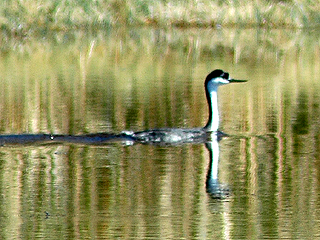--
Clark's Grebe
 Clark's Grebe is a striking water bird found mainly in western North America. It closely resembles the Western Grebe, but you can tell them apart by the color of their bills—Clark's Grebe has a bright yellow-orange bill, while the Western Grebe's is more greenish-yellow. Another key difference is in their eyes; Clark's Grebe has white feathers around its eyes, which stand out against its black head.
Clark's Grebe is a striking water bird found mainly in western North America. It closely resembles the Western Grebe, but you can tell them apart by the color of their bills—Clark's Grebe has a bright yellow-orange bill, while the Western Grebe's is more greenish-yellow. Another key difference is in their eyes; Clark's Grebe has white feathers around its eyes, which stand out against its black head.
These birds are known for their elaborate courtship displays, where they perform synchronized dances on the water's surface. They dive for fish and other aquatic creatures, often seen gliding gracefully across lakes and reservoirs. Clark's Grebe is a fascinating bird, especially when you catch a glimpse of its graceful dance. Clark's Grebe (Aechmophorus clarkii) is a species of waterbird belonging to the grebe family. It is primarily found in freshwater lakes, marshes, and reservoirs in western North America, particularly during the breeding season. Here’s a closer look at some of the key details about Clark's Grebe:
Physical Characteristics:
Size: Clark's Grebe is a medium-sized bird, typically measuring about 22 to 29 inches (56 to 74 cm) in length, with a wingspan of around 24 inches (61 cm).
Plumage: The bird has a striking appearance with a black-and-white color scheme. Its upper parts are black, and its underparts are white. The neck is long and slender, and the black cap extends below the eye, distinguishing it from the Western Grebe, whose black cap stops above the eye.
Bill: One of the most distinguishing features is its bright yellow-orange bill, which is slightly upturned.
Eyes: Clark's Grebe has bright red eyes, surrounded by white feathers, giving it a distinctive look.
Behavior:
Feeding: Clark's Grebe primarily feeds on fish, which it catches by diving underwater. It also consumes small crustaceans, insects, and occasionally amphibians. The bird is an excellent diver, capable of staying submerged for long periods while chasing prey.
Courtship: Clark's Grebe is famous for its elaborate courtship rituals, which include a synchronized "rushing" display. During this display, a pair of grebes will rise up and run across the water's surface side by side, paddling furiously with their feet while keeping their bodies upright.
Nesting: These birds nest in colonies, usually building floating nests anchored to vegetation in shallow water. Both parents share the responsibility of incubating the eggs, which typically number 2 to 4.
Habitat and Range:
Breeding Habitat: Clark's Grebe breeds in large freshwater lakes, marshes, and reservoirs across western North America, from the Canadian Prairies down to Mexico. They prefer areas with plenty of open water and dense vegetation where they can build their nests.
Migration: After the breeding season, many Clark's Grebes migrate to coastal waters, particularly along the Pacific coast, where they spend the winter.
Conservation Status:
Population: The population of Clark's Grebe is generally stable, though like many waterbirds, it faces threats from habitat loss, pollution, and human disturbance. Conservation efforts focus on protecting wetland habitats and reducing pollution in their breeding and wintering areas.
Clark's Grebe is a fascinating bird not only for its beauty but also for its unique behaviors, especially its courtship dance. Watching these birds perform their synchronized water dance is a sight to behold and highlights the intricate social behaviors in the animal kingdom.
Here are some sources that provide detailed information on Clark's Grebe:
Cornell Lab of Ornithology - All About Birds: This is a reliable source for detailed information on bird species, including identification, behavior, and habitat. All About Birds - Clark's Grebe.
Audubon Society: The Audubon Society offers comprehensive profiles on various bird species, including the Clark's Grebe, with insights into their habits, migration patterns, and conservation status. Audubon - Clark's Grebe.
The Birds of North America (BNA) Online: This resource provides in-depth scientific data on bird species, including Clark's Grebe, covering aspects like breeding, diet, and behavior. It may require a subscription for full access. BNA - Clark's Grebe.
These sources offer extensive and reliable information about Clark's Grebe, suitable for both casual birdwatchers and more serious ornithologists.
Aechmophorus clarkii
The Clark's Grebe is black-and-white, with a long, slender, swan-like neck. It ranges in size from 22"-29".
Among its distinguishing features is its bill, which is slightly upturned and bright yellow, whereas the Western Grebe's bill is straight and greenish-yellow. It shows white around its eyes, whereas black appears around the eyes of the Western Grebe. The downy young are white, not gray.
This species nests on large inland lakes in western North America and migrates to the Pacific coast in winter. It feeds by diving for carp, herring, mollusks, crabs, and salamanders.